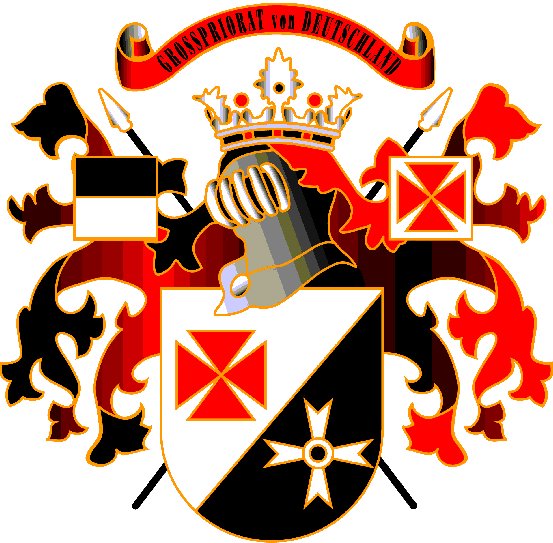|
|
|||||||||||||
|
GREAT PRIORY OF GERMANY |
|||||
 |
|||||
|
The Antient Military, Religious and Masonic Order of the Teutonic Knights in Germany History and Legend A medieval military Order was founded in 1190 during the siege of Acre when a hospital brotherhood was established with the co-operation and care of Frederick of Suabia, to care for the many sick German crusaders. It was originally modelled upon the Hospitalers of St John and changed its residence as often as the latter. In 1192 it was granted the same Privileges as the Order of Knights Templar and the Order of St John, the latter, under the Jurisdiction of which, many of the original military Knights had fought, and took its place beside these two Orders and as an Order of the Temple. In 1198 it was given a building after the conquest of the city of Acre, which it turned into a military-monastic Order on the model of the Knights Templars and other Orders at that time. This creation reflected the growing involvement of the Hohenstaufen dynasty in the Holy Land. There was already a Teutonic hospital for pilgrims from Germany in the Latin Kingdom of Jerusalem but the Order from the start had a military policy of conquering land and building up independent territories in the Holy Land. The military-monastic Knights had become a fully fledged military and religious Order for the defence of Pilgrims. During the fourth Crusade when the gates were opened for the last time to Christians (1229) the Teutonic Military Knights were able to take possession of their first house (St Mary of the Germans) but it was not long before the end of the Century that they left Palestine which had again fallen under the yoke of Islam. A new career opened for the warlike military Knights and with their renowned religious zeal they were reformed to fight against the pagans of Prussia and as late as 1211-25 in Hungary and later in Prussia absorbed the „Sword Brethren" in Lavonia into their military section of the Order. During the Reformation the Order including the Military Knights was secularised. The Military Knights by now exclusively nobility came to form an independent political entity. 3 It is to these Military / Chivalric Knights of the Teutonic Order to whom we dedicate our Order, the membership of which is restricted solely to the Knight Commanders and Knights Grand Cross of The Great Priory of Germany, Order of Knights Templar, who have had conferred upon them the antient Secrets of a Knight Commander and/or Knight Grand Cross of the combined religious Orders of the Temple and of Malta within the Great Priory of Germany. As a footnote, the remaining religious Hospitalers now long since a separate Order from the Military Teutonic Knights, and supporting a habit of White Mantle and black Pattée Cross continued their pastoral work but were eventually expelled from most German States and reduced at that time to only four Members, but have continued to survive in Austria to the present day. In its current form this Order the Hochmeister of which resides in Vienna has approximately 87 brethren and 294 sisters who are bound to celibacy, while they enjoy the benefits of this now purely pastoral Order. Heraldry of he Order Heraldry of the Order which is an Argent Cross sable surmounted on a white Jerusalem Cross with the symbolic Escutcheon depicting a black double-headed eagle on a background of gold as adapted from an original design by an early Knight, Frederick II of Hohenstaufen Armorial Interpretation The potent Argent Cross in black depicts the early heraldry of a Christian Knight which was supposedly introduced by Emperor Henry IV. It is symbolic of the struggle by the Crusaders against the Infidels and denotes courage, valour and defence of the Christian faith. The white Jerusalem Cross was the symbolic badge of the Christian Knights during the Crusades, and signifies dedication and immortality. The centre of the four points of the cross denotes the fourfold mystery of the Cross. The Escutcheon depicting a double headed black Eagle 4 representing watchfulness is to commemorate the Christian charity and shelter afforded to German Pilgrims and Knights during the early Crusades in the Holy Land. The gold of the background, one of the two metals used in heraldry, symbolises faith, justice and mercy and signifies nobility, generosity and love. Qualifications for Membership and Authority The restricted ceremonies to be known within the Great Priory of Germany as the "Degrees of the Antient Military, Religious and Masonic Order of Teutonic Knights in Germany" may only be conducted by the ME Grand Master or the ME/RE Knight entrusted by the Grand Master for the conferral of the antient Degrees. He will as such, be personally authorised to entrust the secrets and confer these Grades of Knighthood solely upon appointed Knights Commander and Knights Grand Cross within the Great Priory of Germany. Appointed Knight Commanders or Knights Grand Cross within the Great Priory of Germany must become Members of the Order. Knights Commander and Knights Grand Cross appointed and invested within the Great Priory of Germany prior to Ist April 2008 will have the Grades conferred but will have no additional precedence within the Order. The Order is restricted to 25 Members at any one time. Honorary membership may only be granted to a maximum of three qualified Knights Commander or Knights Grand Cross of the originating Great Priory. Past Grand Masters of the Great Priory of Germany prior to 2004 will, after conferral of the Grades, be granted the rank and Title of Honorary Ordensmeister
|
|||||
| [Home] [About us] [Locations] [Qualification] [Bodies in Amity] [Knights of Malta] [Teutonic Knights] [History] [News] [Impressum] |